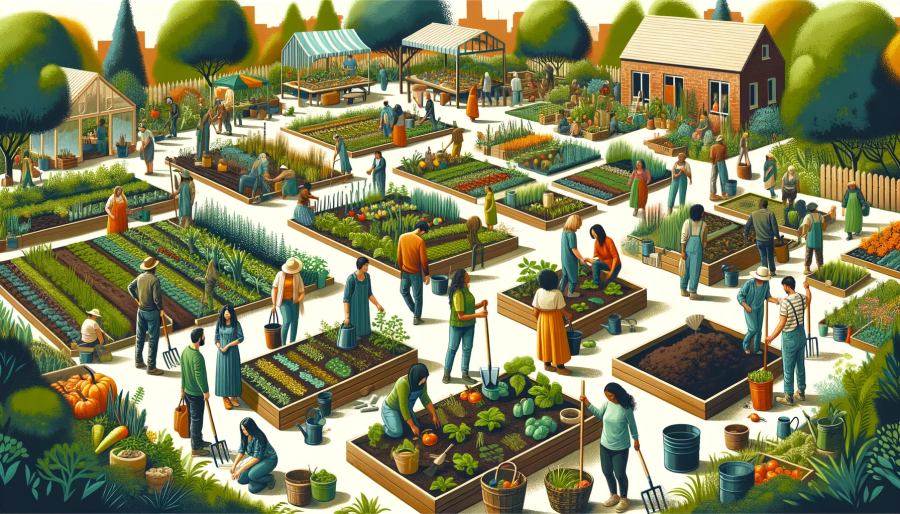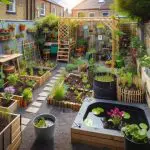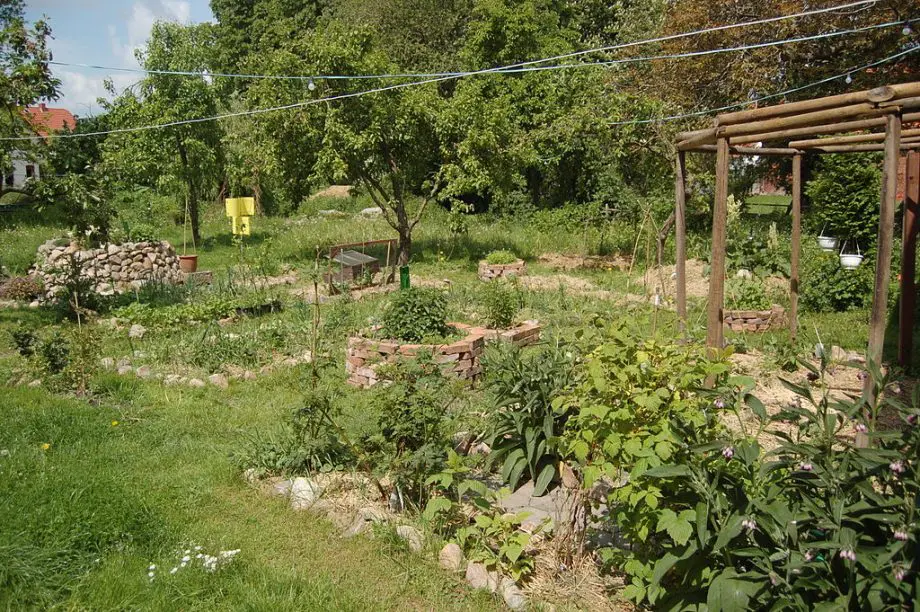
Dive into the world of permaculture gardening! Discover sustainable, eco-friendly techniques to transform your garden into a thriving, self-sustaining oasis.
Permaculture Gardening Key Takeaways:
- Permaculture gardening is a sustainable approach to agriculture that mimics natural ecosystems.
- It integrates land, resources, people, and the environment through mutually beneficial synergies.
- Emphasizing ecological and biological processes over synthetic inputs, creating self-sustaining, productive gardens.
Welcome to the vibrant world of permaculture gardening, where nature and sustainability meet to create thriving gardens.
This guide is your doorway to understanding and implementing permaculture principles, turning your garden into an eco-friendly haven that nurtures both the environment and your soul.
Introduction to Permaculture Gardening
Permaculture gardening is a revolutionary approach to cultivating land, harmonizing with nature rather than working against it.
This concept, coined by Bill Mollison and David Holmgren, emphasizes sustainable agriculture by integrating human needs with the natural world.
It’s not just about growing food; it’s a holistic approach to creating self-sustaining ecosystems.
Whether in sprawling rural landscapes or compact urban spaces, permaculture principles apply universally, offering solutions for efficient, low-maintenance gardening.
This guide delves into the essence of permaculture gardening, exploring its principles, techniques, and benefits.
It’s a journey through understanding how we can align our gardening practices with the rhythms of the natural world, creating spaces that are not only productive but also sustainable and harmonious.
What Is Permaculture
Permaculture integrates land, resources, people and the environment through mutually beneficial synergies – imitating the no waste, closed loop systems seen in diverse natural systems. Permaculture News
Principles of Permaculture

Permaculture is more than just a gardening technique; it’s a philosophy encompassing a set of principles that guide sustainable and harmonious living with nature.
Coined by Bill Mollison, the term permaculture blends ‘permanent’ with ‘agriculture,’ emphasizing practices that sustain natural ecosystems over time.
This section explores the core principles of permaculture, which are fundamental in understanding how it differs from traditional gardening methods.
These principles are not just guidelines for growing food but are a blueprint for a sustainable lifestyle, addressing the holistic needs of both humans and the environment.
Ethics and Design Principles
Permaculture is grounded in ethics and design principles that prioritize the earth and its inhabitants.
These principles, conceptualized by Bill Mollison, advocate for care of the earth, care of people, and fair share.
They guide us in creating systems that meet human needs while preserving the natural ecosystems.
Understanding Ecosystems
At the heart of permaculture is a deep understanding of natural ecosystems.
This involves observing and learning from nature’s patterns and cycles.
By mimicking these systems, permaculture gardens become self-sustaining, requiring less effort and resources while yielding abundant harvests.
Applying Permaculture in Various Environments
Permaculture’s versatility allows it to be applied in diverse environments, from large rural areas to small urban spaces.
Key techniques like companion planting, sheet mulching, and the use of perennial plants enhance soil health and biodiversity.
In urban settings, backyard permaculture with innovative approaches like keyhole gardens and container gardens makes efficient use of limited space.
Find out about building hugelkultur raised beds.
Find out how to build a keyhole garden.
Permaculture principles adapt to local climates and environments, ensuring that each garden is uniquely suited to its surroundings.
This adaptability makes permaculture a viable solution for sustainable agriculture globally, addressing the threat of climate change and promoting ecological balance.
Planning Your Permaculture Garden
Creating a permaculture garden begins with thoughtful planning and design, tailored to your specific environment and needs.
This process is a key first step in establishing a garden that not only produces abundant food but also functions as a self-sustaining ecosystem.
Whether you have a large area or just a small space, the principles of permaculture can be applied to create a harmonious and productive garden.
This section covers the essential steps in planning your permaculture garden, from understanding your land to selecting the right plants.
Site Analysis and Design
Effective permaculture garden design starts with a thorough site analysis.
Observe your garden space throughout the seasons to understand sun exposure, wind patterns, and water flow.
This knowledge helps in creating a design system that works with your local environment, ensuring the best use of natural resources.
Choosing the Right Plants
Selecting the right plants is crucial in permaculture. Focus on native plants and perennial varieties that thrive in your local climate.
Fruit trees and edible perennials are excellent choices, as they provide food and contribute to soil health.
Consider the relationships between different plants to maximize companion planting benefits.
Zoning and Sector Planning
Permaculture gardens are organized into zones based on the frequency of human use and plant needs.
Place elements like kitchen gardens and compost bins in zones you’ll visit daily.
Less frequently tended elements, like fruit trees, can be positioned further away.
Sector planning involves understanding and utilizing natural forces such as sunlight and wind.
For instance, tall plants or structures can be placed strategically to provide shade or wind protection to more sensitive areas.
Soil Health and Management
Soil is the foundation of a permaculture garden. Focus on building healthy soil rich in organic matter through methods like composting and sheet mulching.
These practices not only nourish the soil but also recycle organic materials like kitchen scraps and garden waste.
Healthy soil leads to robust plant growth and reduces the need for external inputs, making your garden more sustainable and low maintenance.
Techniques and Practices in Permaculture Gardening
Permaculture gardening is distinguished by its unique techniques and practices that align closely with natural systems.
These methods are designed to create a sustainable, low-maintenance garden that supports biodiversity and ecological balance.
From companion planting to water conservation, permaculture techniques are about working with nature, not against it.
This section delves into some of the most effective permaculture practices that can be applied in gardens of all sizes.
Companion Planting
Companion planting is a cornerstone of permaculture gardening.
This practice involves growing different plants together to enhance growth, deter pests, and improve soil health.
For example, planting marigolds in vegetable gardens can help repel harmful insects, while growing beans near corn can increase nitrogen in the soil.
Companion planting creates a diverse, resilient garden ecosystem where plants support each other, reducing the need for chemical fertilizers and pesticides.
Natural Pest Control
In permaculture, the focus is on preventing pest problems naturally.
This involves encouraging beneficial insects, like ladybugs and bees, which help control pest populations and pollinate plants.
Planting a variety of species creates a balanced ecosystem where pests are less likely to dominate.
Techniques like crop rotation and using natural barriers also play a role in keeping pests at bay, ensuring a healthy garden without relying on harmful chemicals.
Water Conservation Strategies

Water conservation is vital in permaculture gardening. Techniques like rainwater harvesting, using rain barrels, and drip irrigation ensure efficient water use.
Mulching helps retain soil moisture and reduces water evaporation.
Designing your garden to capture and store energy from natural water sources, like rain and dew, minimizes the need for external watering, making your garden more sustainable and resilient, especially in areas with water scarcity.
Mulching and Composting

Mulching and composting are essential for maintaining soil health in permaculture gardens.
Mulching with organic materials like straw, grass clippings, or dead plants helps suppress weeds, retain moisture, and add nutrients to the soil.
Composting kitchen scraps and garden waste transforms organic matter into rich compost, a natural fertilizer that enhances soil life.
These practices not only nourish the garden but also recycle waste, embodying permaculture’s principle of sustainable living.
Permaculture Plants and Crops
In permaculture gardening, the choice of plants and crops is pivotal to the success and sustainability of the garden.
This section focuses on selecting plants that not only thrive in your garden’s specific conditions but also contribute to the overall health and balance of the ecosystem.
From fruit trees to perennial vegetables, the right plants can transform your garden into a productive and self-sustaining space.
Top Permaculture Plants
Permaculture gardens often feature a variety of plants, each serving multiple purposes. Fruit trees like apples and pears are popular for their yield and shade.
Perennial vegetables, such as asparagus and rhubarb, provide food year after year.
These plants form the backbone of a permaculture garden, offering both food and ecological benefits.
Perennial Vegetables and Herbs
Perennial plants are a mainstay in permaculture due to their low maintenance and long-term yield.
They include not only vegetables but also herbs like rosemary, lavender, and thyme.
These plants return each year, reducing the need for replanting and providing a consistent supply of food and medicinal herbs.
Planting for Biodiversity
Biodiversity is key in permaculture gardens. A mix of different plants creates a resilient and balanced ecosystem.
This includes a variety of vegetable gardens, medicinal herbs, and native plants that attract beneficial insects and support local wildlife.
Planting for biodiversity also means considering the layers of a garden, from tall trees to ground cover, each playing a role in the garden’s health.
This approach not only enhances the garden’s productivity but also its beauty, making it a thriving hub for both humans and nature.
Implementing Permaculture in Small Spaces
Permaculture isn’t limited to large, sprawling gardens; it’s equally effective in small areas and urban settings.
This section explores how the principles of permaculture can be adapted to smaller spaces, offering creative solutions for urban gardeners and those with limited outdoor areas.
By maximizing the use of space and resources, permaculture can turn even the smallest plot into a productive and sustainable garden.
Urban Permaculture Techniques

Urban permaculture focuses on maximizing limited space through vertical gardening, container gardens, and rooftop gardens.
Techniques like trellising and using wall spaces for growing climbing plants can significantly increase the growing area.
Urban permaculture also emphasizes the importance of community gardens, where shared spaces can be transformed into productive gardens, fostering community engagement and providing fresh, local produce.
Vertical and Container Gardening
Vertical and container gardening are perfect for small spaces. Containers can be used to grow a variety of plants, from herbs to small fruit trees, and can be placed on balconies, patios, or windowsills.
Vertical gardening involves using trellises, wall planters, and hanging baskets to grow plants upwards rather than outwards, making efficient use of vertical space.
These methods allow for a diverse range of plants, ensuring a productive garden even in the smallest of spaces.
Permaculture and Community
Permaculture extends beyond individual gardens, playing a significant role in community development and social sustainability.
This section highlights how permaculture principles can be applied to foster community engagement, sharing of resources, and collective learning.
Community gardens and shared knowledge are vital components of permaculture, emphasizing its potential to meet human needs through collaborative efforts and sustainable practices.
Community Gardens

Community gardens are a great example of permaculture in action at a communal level.
They provide a space for people to come together, grow their own food, and learn from each other.
These gardens often become hubs of knowledge sharing about sustainable practices like organic farming and gardening, and local food production.
They embody the permaculture ethic of ‘fair share,’ promoting equitable access to resources and knowledge.
Sharing Knowledge and Resources
Permaculture is as much about building community as it is about gardening.
Sharing knowledge and resources, like seeds, tools, and expertise, is common in permaculture communities.
Workshops, permaculture courses, and informal gatherings are avenues for learning and sharing.
This collaborative approach not only strengthens community bonds but also helps in spreading permaculture principles more widely, contributing to a more sustainable and resilient society.
Seasonal Planning and Crop Rotation in Permaculture
Permaculture gardens thrive on understanding and adapting to the natural rhythms of the seasons.
This section delves into the importance of seasonal planning and crop rotation, essential practices for maintaining a healthy and productive permaculture garden throughout the year.
Understanding Seasonal Changes
Each season brings different conditions – temperature, light, and moisture levels – that affect plant growth.
Adapting your gardening activities to these changes, such as planting season-appropriate crops and preparing for weather shifts, is crucial for a successful permaculture garden.
Benefits of Crop Rotation
Crop rotation is a key permaculture technique. It involves changing the location of crops each season to prevent soil depletion, reduce pest and disease buildup, and improve soil fertility.
This practice ensures a diverse and balanced garden ecosystem, leading to healthier plants and a more abundant harvest.
Planning for Succession Planting
Succession planting, or planting crops at staggered times, ensures a continuous harvest.
This method maximizes garden productivity by efficiently using space and resources.
It involves planning ahead to replace harvested crops with new ones, considering the specific needs and growing times of each plant.
Seasonal Garden Maintenance
Seasonal maintenance tasks, such as mulching in winter to protect soil, pruning in spring to encourage growth, and harvesting in summer and fall, are vital.
These practices keep the garden healthy and productive, aligning gardening activities with the natural lifecycle of the plants and the ecosystem.
Integrating Livestock in Permaculture
Incorporating animals into a permaculture system can enhance its sustainability and productivity.
This section explores how livestock can be integrated into permaculture gardens, contributing to a more dynamic and self-sustaining ecosystem.
The Role of Chickens
Chickens are a popular choice in permaculture systems. They provide natural pest control by eating insects, contribute to soil fertility through their manure, and offer a source of fresh eggs.
Designing a chicken-friendly garden involves creating safe, accessible spaces for them to roam and forage.
Benefits of Bees
Bees play a crucial role in pollinating plants, which is essential for fruit and vegetable production.
Keeping bees in a permaculture garden increases plant diversity and yield.
Providing flowering plants and safe habitats encourages bees to visit and stay in the garden.
Other Beneficial Animals
Other animals like ducks, goats, and rabbits can also be integrated into permaculture systems.
Ducks help control slugs and snails, goats can manage overgrown areas, and rabbits provide manure.
Each animal contributes uniquely to the garden’s health and productivity.
Find out how homesteading and permaculture can coexist together.
Ethical Considerations and Care
When integrating animals into a permaculture garden, their welfare and ethical treatment are paramount.
This includes providing adequate shelter, food, and care, ensuring they have enough space, and considering their natural behaviors.
A well-planned integration benefits both the animals and the garden.
Permaculture in Different Climates
Permaculture principles are versatile and adaptable to various climatic conditions.
This section discusses how to tailor permaculture practices to different climates, ensuring that gardens remain productive and sustainable whether in a tropical, temperate, arid, or cold environment.
Adapting to Arid Climates
In arid climates, water conservation is crucial. Techniques like rainwater harvesting, drought-resistant plants, and mulching to retain soil moisture are essential.
Designing the landscape to capture and store water, such as through swales or rain gardens, can significantly improve water efficiency.
Thriving in Tropical Climates
Tropical climates offer abundant rainfall and year-round growing seasons.
Emphasis should be on managing excess moisture and taking advantage of the long growing season.
Plants that thrive in high humidity and heat, and strategies to prevent soil erosion, are key in these environments.
Permaculture in Cold Climates
In colder regions, the focus is on extending the short growing season.
Techniques like using greenhouses, cold frames, and choosing cold-hardy plants can make a significant difference.
Maximizing sunlight exposure and protecting plants from frost are also important considerations.
Strategies for Temperate Climates
Temperate climates, with their distinct seasons, require a balanced approach.
Seasonal planning, crop rotation, and using a variety of plants suited for different times of the year are vital.
Building soil health to withstand the varying conditions is also a key strategy in these regions.
Dive into the pros and cons of permaculture.
Case Studies and Real-world Examples of Permaculture
Real-world examples and case studies provide valuable insights into the practical application of permaculture principles.
This section highlights successful permaculture projects and gardens, offering inspiration and practical lessons for readers.
Urban Permaculture Projects
Urban permaculture projects demonstrate how principles can be adapted to city environments.
Examples include rooftop gardens, community gardens, and balcony gardens that utilize vertical space, container planting, and local resource recycling, showcasing the adaptability of permaculture in densely populated areas.
Rural Permaculture Farms
Rural permaculture farms often serve as larger-scale demonstrations of sustainable agriculture.
These farms integrate crop diversity, livestock, water management systems, and renewable energy sources, providing a comprehensive view of how permaculture can create self-sufficient and resilient agricultural systems.
School and Community Gardens
School and community gardens using permaculture principles not only produce food but also serve as educational tools.
They engage students and community members in learning about sustainable practices, food systems, and ecological stewardship, fostering a sense of community and environmental responsibility.
International Permaculture Initiatives
International permaculture initiatives highlight the global applicability of permaculture principles.
Projects in diverse regions, from Africa to Asia, adapt permaculture to local conditions and needs, addressing issues like food security, soil degradation, and water scarcity, and demonstrating the universal relevance of permaculture solutions.
Community Involvement and Education in Permaculture
Permaculture is not just about individual gardens; it’s also about community involvement and education.
This section explores how permaculture principles can be used to foster community spirit and educate people about sustainable living.
Building Community Through Permaculture
Permaculture projects often bring people together, creating a sense of community.
Community gardens, shared workshops, and group projects encourage collaboration and knowledge sharing.
These initiatives help build stronger, more connected communities where members support each other and work together towards common environmental goals.
Educational Opportunities in Permaculture
Permaculture offers numerous educational opportunities, from formal courses and certifications to informal workshops and garden tours.
These educational experiences provide practical knowledge and hands-on skills in sustainable gardening, ecosystem design, and environmental stewardship, empowering individuals to make positive changes in their own lives and communities.
Permaculture in Schools
Integrating permaculture into school curriculums can provide valuable lessons in ecology, biology, and environmental science.
School gardens designed with permaculture principles offer students hands-on learning experiences about food systems, sustainability, and the importance of biodiversity, fostering a new generation of environmentally conscious individuals.
Public Awareness and Outreach
Raising public awareness about permaculture and its benefits is crucial for broader adoption.
Outreach efforts can include community demonstrations, public talks, and social media campaigns.
These initiatives help spread the word about permaculture, inspiring more people to adopt sustainable practices in their gardening and daily lives.
Challenges and Solutions in Permaculture
While permaculture offers many benefits, practitioners may encounter specific challenges.
This section addresses common issues in permaculture gardening and provides practical solutions, helping gardeners overcome obstacles and maintain thriving ecosystems.
Dealing with Pests and Diseases
Natural pest control is a cornerstone of permaculture, but challenges can arise.
Encouraging beneficial insects, using companion planting, and practicing crop rotation are effective strategies.
If pests persist, organic, non-toxic pest control methods can be employed as a last resort, ensuring minimal impact on the garden’s ecosystem.
Soil Fertility Management
Maintaining soil fertility is crucial but can be challenging, especially in poor soil conditions.
Regularly adding organic matter, practicing composting, and using green manures can significantly improve soil health.
Additionally, soil testing can provide valuable insights, allowing for targeted amendments to address specific deficiencies.
Water Management in Dry Climates
In dry climates, water scarcity can be a major challenge. Implementing water-saving techniques like mulching, drip irrigation, and rainwater harvesting are essential.
Designing the landscape to maximize water retention, such as through swales or terracing, can also help conserve water.
Adapting to Changing Climate Conditions
Climate change poses a significant challenge, with shifting weather patterns and extreme conditions.
Permaculture gardens must be adaptable, with a focus on planting diverse, climate-resilient species.
Building robust, healthy soil and creating microclimates within the garden can also help buffer against climatic extremes.
Conclusion: The Future of Permaculture Gardening
Permaculture gardening represents a hopeful and practical approach to sustainable living and environmental stewardship. This conclusion reflects on the impact of permaculture and its potential for shaping a more sustainable future.
The Growing Importance of Permaculture
As environmental concerns like climate change and biodiversity loss become more pressing, permaculture’s holistic and sustainable approach to gardening and land use becomes increasingly important.
It offers a viable solution for creating resilient food systems and restoring ecological balance.
Uncover the difference between permaculture and regenerative agriculture.
Permaculture’s Role in Global Sustainability
Permaculture extends beyond individual gardens, contributing to global sustainability efforts.
Its principles can be applied to various scales, from small urban gardens to large agricultural systems, making it a key player in the movement towards a more sustainable and equitable world.
Empowering Communities and Individuals
Permaculture empowers communities and individuals by providing tools and knowledge for sustainable living.
It fosters self-sufficiency, resilience, and a deeper connection with nature, encouraging people to take an active role in caring for the environment and their local communities.
Looking Ahead
As permaculture continues to evolve and gain popularity, its potential for positive change is immense.
By embracing permaculture principles, we can collectively work towards a future where sustainable practices are the norm, ensuring a healthy planet for generations to come.
FAQs on Permaculture Gardening
Permaculture gardening, with its unique approach and principles, often raises questions, especially for those new to the concept.
This FAQ section aims to address some of the most common inquiries, providing clear and concise answers.
These questions reflect the curiosity and common challenges faced by many when first exploring permaculture gardening.
Q: What are the basic principles of permaculture gardening?
A: The basic principles of permaculture gardening revolve around working with nature, not against it.
They include observing and interacting with the natural world, capturing and storing energy, obtaining a yield, applying self-regulation and accepting feedback, using and valuing renewable resources, and designing from patterns to details.
Q: How do I start a permaculture garden in a small space?
A: To start a permaculture garden in a small space, focus on vertical and container gardening to maximize space.
Utilize balconies, patios, and even windowsills. Choose plants that are suitable for small areas and consider using companion planting to enhance growth and pest control.
Q: What are some common permaculture plants?
A: Common permaculture plants include perennial vegetables like asparagus and rhubarb, fruit trees such as apple and pear, and herbs like rosemary and thyme.
These plants are chosen for their ability to thrive with minimal intervention and for their contributions to the garden’s ecosystem.
Q: How does permaculture contribute to sustainability?
A: Permaculture contributes to sustainability by creating self-sufficient, resilient gardens that mimic natural ecosystems.
It emphasizes the use of renewable resources, promotes biodiversity, and focuses on soil health and water conservation.
Permaculture gardens are designed to be sustainable in the long term, with minimal environmental impact.
Permaculture Gardening Conclusion
Permaculture gardening is more than just a method of cultivation; it’s a sustainable lifestyle choice.
By embracing the principles of permaculture, gardeners can create ecosystems that are not only productive but also in harmony with nature.
This approach to gardening offers a path towards a more sustainable and resilient future.
Permaculture gardening transcends traditional gardening methods, offering a sustainable and ecologically sound approach to cultivating land.
This conclusion reflects on the key aspects of permaculture and its broader implications for our relationship with the natural world.
Learn about The 5 Principles of Regenerative Agriculture
Embracing a Sustainable Lifestyle
Permaculture is not just about growing food; it’s about adopting a lifestyle that respects and works with nature, promoting sustainability in every aspect of living.
Benefits to the Environment and Society
By implementing permaculture principles, gardeners contribute to environmental health and community well-being. This approach fosters biodiversity, soil regeneration, and sustainable food systems, benefiting both nature and society.
Regeneration in Practice: 73 global projects transforming community and ecosystems – Permaculture







